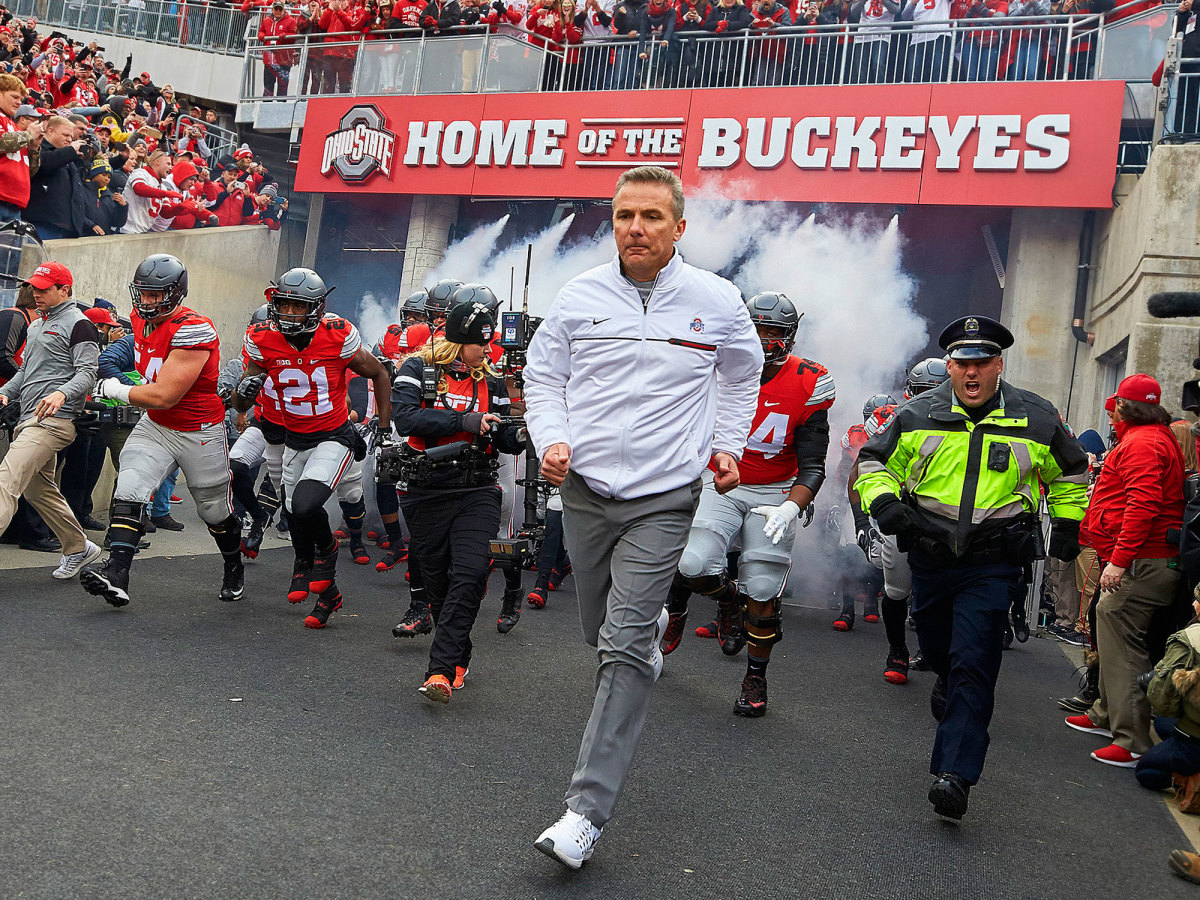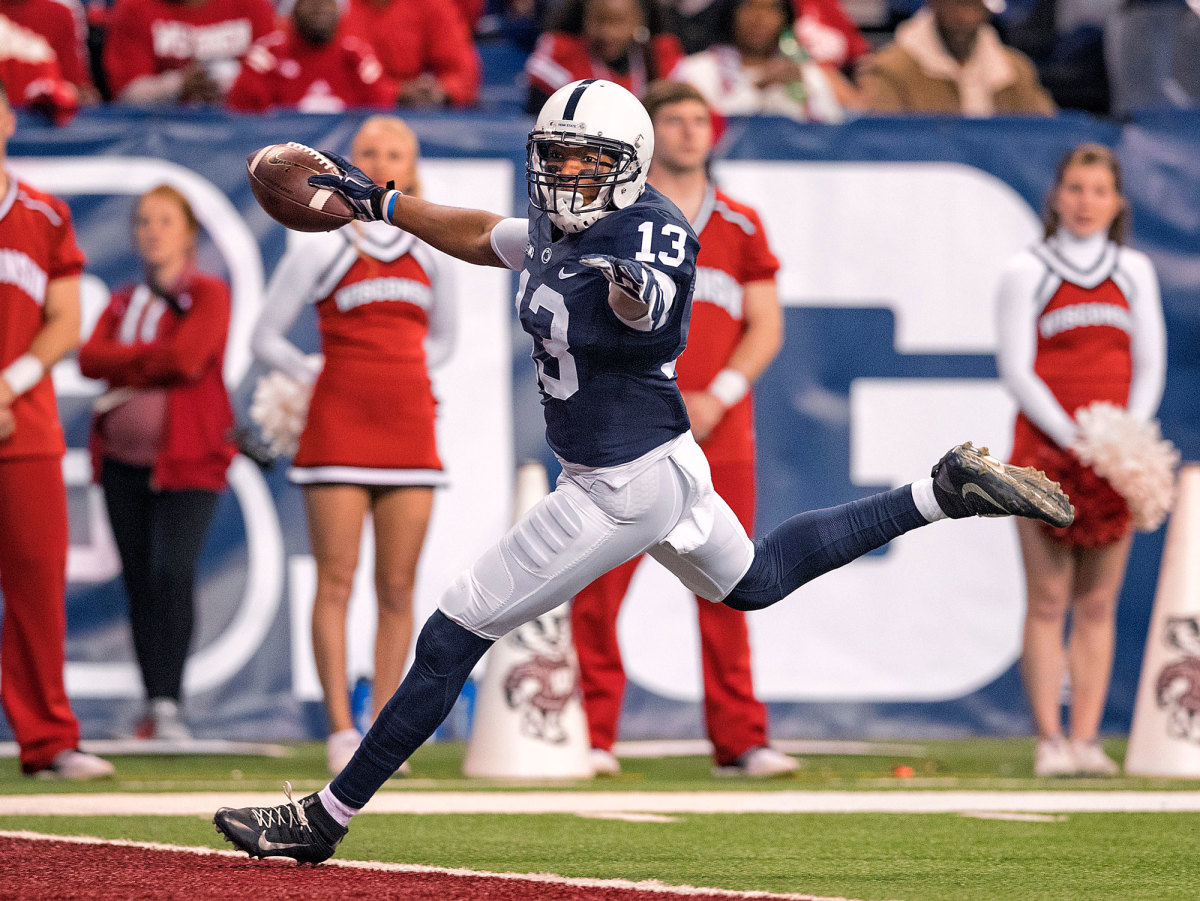A League Ahead: Inside the Big Ten's return to the top of college football

If history is written by the victors, then the story of the 2012 Big Ten championship game should be written by nobody. It was not much of a game, it should not have decided a championship, and it made the proud Big Ten look like it was selling fake Rolexes in a dark alley.
The game was supposed to pit the champions of the self-importantly-named Legends and Leaders divisions. But the Leaders' leader, undefeated Ohio State, was ineligible because of NCAA violations. So was second-place Penn State. That left third-place Wisconsin—which went 4–4 in the league—to face Legends champion Nebraska.
The Badgers drilled the Cornhuskers 70–31. Wisconsin coach Bret Bielema was so impressed, he immediately left for Arkansas of the Southeastern Conference, saying he wanted a better chance to win a national championship. It was hard to argue with that reasoning. The same day the Big Ten held its faux championship game, the SEC held what was basically its title game and the national championship game simultaneously. Alabama beat Georgia, then proceeded with the formality of whipping Notre Dame to finish No. 1.
The Big Ten was not just behind the SEC; it also appeared to be running in a different race, on a slower track. Critics ripped the Big Ten for bringing in East Coast nonpowers Rutgers and Maryland just to add TV markets. They said league members were too collegial in a cutthroat world. They carped that Big Ten schools were picky with coaching hires, focusing too much on school connections and cultural fits. They said the league was touting its tradition and passionate Midwest fan bases, but population shifts meant there was more talent in the South.
All of it was true. But these points weren't flaws. They are the very qualities that have fueled the Big Ten's revival.
***
The game of this season in college football—2016's version of that 2012 Alabama-Georgia tussle—took place in Columbus, Ohio, on Nov. 26. Ohio State beat Michigan 30–27 in double overtime. Afterward, Ohio State coach Urban Meyer, who won two national championships at Florida and another at OSU, said it may have been the best game of his career.
Neither team advanced to the Big Ten title game, but this time there was a good reason: The conference has too many great teams. It is the best league in the country, at least at the top, according to those whose opinions matter most. Four of the top eight teams in the final College Football Playoff rankings were from the Big Ten.
No. 2 Ohio State and No. 5 Michigan had to watch Penn State beat Wisconsin 38–31, though the Buckeyes did so knowing they were a virtual lock to make the playoff. Penn State tied Ohio State atop the Big Ten East standings—Legends and Leaders are long gone—and Penn State won the tiebreaker because it beat the Buckeyes.
This was the kind of stacked league that Meyer envisioned when he called out the Big Ten in 2012, telling SI, "I think, the Big Ten, it's time to jump to it ... I mean that in a respectful way. We better get going."
It got going, all right. Meyer says, "You didn't see the athletes on defenses when I got here that you see now." What he won't say, at least publicly, is that this year's 11–1 Buckeyes would crush his undefeated 2012 team.

"It's not even close," says Rutgers coach Chris Ash, a former Ohio State and Wisconsin assistant. "That was a completely different team than what he has right now. He just has more weapons."
When Meyer arrived at Ohio State at the end of the 2011 season, the work of improving the conference had already begun. Ohio State athletic director Gene Smith says it was a continuous topic of discussion among Big Ten ADs. They moved toward a nine-game league schedule, eliminating one September nonconference cupcake. And, Smith says, "we talked more about making sure we all had the investments necessary in recruiting."
Investments require capital, and two of the conference's apparent cash grabs—the creation of the Big Ten Network, and the 2014 addition of Rutgers and Maryland—changed the trajectory of the league.
The network helped drive league revenue to unprecedented levels; the Big Ten brought in $448.8 million in 2014-15, almost $110 million more than it had the year before. Schools have plowed that money back into facilities, support staff and coaching salaries. ("Legitimate facilities for student-athletes," Michigan State athletic director Mark Hollis says, "not the one that is being built for a recruiting photo.") And the revenue cushion allows Big Ten schools to be patient with coaches instead of making quick moves to placate anxious fan bases.
Meyer says, "You have to sell something you believe in. And that starts with the facilities, hiring an excellent coaching staff and paying the coaches too. When people say 'commitment,' I'm not sure they know how much it means."
Can Clemson upset Ohio State, return to title game?
Rutgers and Maryland are nobody's idea of national football powers, but when the Big Ten proclaimed that they expanded the conference's "footprint," it was not just TV jargon. The league's recruiting base expanded in crucial ways. Michigan's two highest-rated recruits in recent years, do-everything Jabrill Peppers and defensive lineman Rashan Gary, are from New Jersey. Ohio State's dynamic receiver Curtis Samuel is from New York City.
And while the Big Ten's recruiting area is still not as rich in talent as the South, the Big Ten has an advantage over the SEC: It owns its real estate almost exclusively. Notre Dame is the only non-Big Ten school in Big Ten territory that can realistically contend for national titles. The SEC shares the South with ACC powers Florida State, Miami and Clemson.
Suddenly, the Midwest is a great place to be.
But some folks already knew that: Big Ten coaches.
***
Big Ten schools have a habit of hiring coaches who don't need a campus map. Meyer is an Ohio native and former OSU graduate assistant. Michigan's Jim Harbaugh is a UM alum and Ann Arbor native. Wisconsin's Paul Chryst is a UW alum, former Badgers assistant and Madison native. Michigan State's Mark Dantonio was an assistant in East Lansing under Nick Saban. Penn State coach James Franklin grew up in Langhorne, Pa. Northwestern coach Pat Fitzgerald is a former Northwestern star and assistant. Iowa coach Kirk Ferentz was a Hawkeyes assistant.
This familiarity means coaches don't have to adjust to their institution's standards, expectations or recruiting area. Big Ten schools don't just want to win. They want to win their way.
Ask Gary Andersen. When Bielema left Wisconsin, athletic director Barry Alvarez brought in Andersen as his replacement. Andersen is an excellent coach, but coach and culture quickly collided—Andersen wanted to lower the school's admissions standards for athletes. Ultimately, culture won. Andersen left for Oregon State, and Alvarez replaced him with Chryst.
"I thought Gary understood," Alvarez says. "I didn't try to hide anything when I hired him. [But] he wanted to do the same thing he had been accustomed to doing at Utah State. Well, that's not going to work here. We're not going to bring in a lot of junior college players here, a lot of at-risk players. We were not going to compromise what we're about for anybody.
Bowl season TV Guide: Rating the watchability of all 40 bowl games
"When he called and told me he was leaving, he said, 'I can't do it the way you want me to do it.' And you move on. But I had no problem sticking with my guns. You have to understand the culture here."
That is true throughout the Big Ten. Michigan had culture clashes with Rich Rodriguez and fired him. Illinois fired Tim Beckman for allegedly mistreating players. Indiana is probably the toughest job in the league—limited in-state recruiting base, long history of losing—but the Hoosiers just forced out Kevin Wilson, even though they were on the verge of a breakthrough. The issue was not the record, but Wilson's personality, which you can apparently use to strip wallpaper. Wilson's alleged mistreatment of players has also come under scrutiny.
Athletic director Fred Glass declined to give specific reasons for the parting but did say, "What might be O.K. at other places, what might be O.K. in an industry, isn't necessarily O.K. here ... I'm proud to be part of an institution that [prioritizes] doing the right thing ahead of competitive success."
That will no doubt sound holier-than-thou to some. And it would be naive to think Big Ten programs are all on their best behavior. (Wilson did last six years, after all.) But while Big Ten schools were committing financial resources to football, they also made a more subtle commitment: to being themselves.
"We're not Ohio State; we're not Michigan," Hollis says. "We started to attain success because we tried to become Michigan State, not somebody else, about a decade ago. If you start to sway back to 'We need it because they have it,' you quickly become put into a position of failure."
Michigan State has become a destination job. Dantonio has done a marvelous job there, yet there has never been a hint that he would leave. There is a reason for that. Michigan State now offers a combination of salary, facilities, stability, environment and championship potential that makes Dantonio and men's basketball coach Tom Izzo stick around.
That is crucial in an era when so many coach-school "relationships" can be broken with a quick call from another school to the coach's agent. Fitzgerald has turned down better jobs because he wants to be at Northwestern, and Northwestern accepted back-to-back five-win seasons because it believes in Fitzgerald. Michigan lured back Harbaugh, ahead of several NFL teams, for one simple reason: He loves the place. And since Michigan fans know it, they embrace the coach's quirks and mini-controversies.
While so many schools around the country have ridiculous expectations, Big Ten schools are more realistic about how much they can win, and how they can do it. Wisconsin, for example, realizes that its program's meat and potatoes has always been guys who eat plenty of meat and potatoes.
As Alvarez says, "If you're in Texas or Ohio or the Southeast, someplace where you have an overabundance of players and speed, you can win a lot of different ways. But when you're sitting here in Wisconsin, we have two handfuls of players a year that are Division I players. The type of player you can consistently recruit here at Wisconsin are linemen. You have to build your program around that."
Wisconsin looks, acts, plays and apparently studies the way a Wisconsin team should. This matters in the Big Ten, and it has proved to be a boon to winning, not a hindrance.
It is easy to mock the Big Ten's vaunted "tradition," its outsized fan bases, and, in some cases, its outsized fans. But those spectators are remarkably loyal, and the brand names are so strong that they can withstand a few bad seasons—or the worst scandal in college sports history.

Most teams would have taken decades to recover from the revelations of Jerry Sandusky's history of child molestation. Penn State made it back in five years. Put your feelings about Joe Paterno and his since-removed statue aside for a moment. (Admittedly, this is not easy.) Penn State's achievements on the field this season, despite earlier scholarship restrictions and the sport's darkest cloud, are exceptional.
"James Franklin has done a marvelous job at Penn State," Smith says. "For him to overcome what he had to overcome, [it could only happen at] a place with great history and tradition.... The platform is there. The talent he has recruited and what he's been able to do is phenomenal."
Smith also points to his rival Up North and says, "Jim Harbaugh is at the top of the pyramid. He is a hell of a coach, one of the best there is."
You might think the Ohio State athletic director would want Michigan to be bad. You would be wrong. Big Ten schools are not just committed to winning; they are committed to each other. Schools share TV and bowl revenue equally. If a school fails to buy its allotment of bowl tickets, every conference member shares in the loss. Even gate receipts from league games are shared (though not evenly) with the rest of the conference. (Newcomers Nebraska, Maryland and Rutgers do not get full revenue shares yet but are on a negotiated path to do so.)
The league's egalitarian principles run deep. Its deal with the Citrus Bowl stipulates that at least five different Big Ten schools take part over the six-year agreement. That gives more schools a chance to make a recruiting impression.
Compare that to what happened in the SEC this fall. Hurricane Matthew postponed LSU's Oct. 8 game at Florida. It was rescheduled for Nov. 19, but LSU and Florida both had nonconference home games that day. LSU athletic director Joe Alleva refused to move the game to Nov. 19 unless it also moved from Gainesville to Baton Rouge. Florida coach Jim McElwain was furious.
That kind of public dispute in the Big Ten is as unlikely as a hurricane postponing a game in Minnesota. As Alvarez says, "There is congeniality and cooperation within that room of athletic directors."
Why Jabrill Peppers should win the Heisman Trophy
Alvarez points out that when the Big Ten initially split into divisions, he was unhappy with Wisconsin's placement, "but I accepted that, because it was best for our league." You never hear Ohio State or Michigan demand a bigger cut of TV revenue just because they are the league's two biggest TV draws. The Buckeyes' Smith says, "We don't want that. We want Pat Fitzgerald, who is one of the best coaches in this country, to have the resources to stay relevant."
Smith says if Ohio State had asked for more TV money, "we would have fragmented the league." We know this is true because it is exactly what happened to the Big 12.
Texas was not content being the Big 12's premier program. Texas wanted to effectively run the league, have its own independent TV channel (the Longhorn Network) and cut the largest piece of pie for itself. In doing that, Texas ignored the old business maxim: Pigs get fat, hogs get slaughtered.
Three of the Big 12's most valuable programs—Nebraska, Texas A&M and Missouri—felt alienated and bolted for other conferences. That weakened the Big 12, and the Longhorns have not been good for seven years. Texas will surely return to contention, but the lousy Big 12 has made the task harder, not easier. Texas wanted to be the biggest star, but it just ended up with a smaller stage.
Hollis says, "If you can surround yourself with greatness, you become a better individual over the long run. That's what the Big Ten is all about and always has been. You can be the greatest athletic department in the world, and if you're the only one, what does that do for you? Your value comes from your interactions with other institutions, other programs."
***
When fans watch Big Ten teams in the postseason, they won't think about culture fits, cooperation between ADs or the expanded footprint. But they will see the fruits of it.
The SEC is still a great league, and Alabama remains the top program in the country. But three of the SEC's marquee schools—Georgia, LSU and Florida—have declined and changed coaches in the past two years. Right now, the Big Ten is the best league in the land, and its ADs keep talking about getting better. Hollis says, "It could come right before kickoff and it could come the day after a very intense game."
Who saw this revival coming? Jim Delany, for one. In February 2007, after Florida whipped Ohio State for the national title and pundits declared that the Big Ten was dead, the Big Ten commissioner fired back with an open letter.
It included this passage:
I love speed and the SEC has great speed, especially on the defensive line, but there are appropriate balances when mixing academics and athletics ... I wish we had six teams among the top 10 recruiting classes every year, but winning our way requires some discipline and restraint with the recruitment process.
The letter went over about as well as Cavaliers owner Dan Gilbert's infamous Comic Sans letter to Cleveland fans after LeBron James left. Delany looked sanctimonious, clueless and desperate. But the Big Ten commissioner's most humiliating moment turned out to be his most prescient.
In that letter, he wrote: "Let's see if the five- and 10-year trend lines hold or whether the recruiting services and talking heads are seeing a new day."
Here we are, 10 years later, and the Big Ten's new day has arrived. And the testimony comes from Florida's head coach in that '07 national-title-game win over Ohio State. Meyer says he can't compare the Big Ten to other leagues this year because "I've been locked in a hole for three months. But I can relate it to the past 20 years I've been coaching, and it's a hell of a conference."
